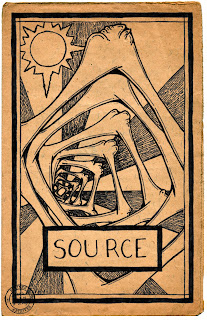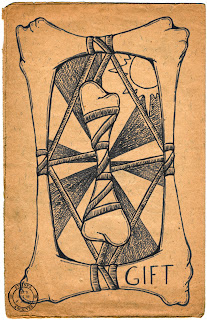In 2008, three years after the death of Charles Jones, a student working on her doctoral dissertation at Steiner College was cataloging his correspondence from the 1990s when she noted that many of the letters from 1994 included copies of drawings that Jones had been working on. After some further research, she found there were two specific series that he kept mentioning: The 10 Images of Incarnation and The 10 Interpretations of the Ox-Herding Sequence. Of each of these, only poor copy and sketches were included in the correspondence. No one had ever seen the originals.
Jones had a somewhat nomadic life, never settling down in any one place for long. Being an exceptionally prolific artist, he often left boxes and trunks full of his work at various locations. After some tracking, seven boxes were found at the 53rd Street Hermitage in Austin, Texas - where Jones had lived for a short time in 1994. Amongst these, were two boxes full of miscellaneous drawings - including the two series mentioned in the correspondence. However, all of the boxes had been stored in an open garage and the contents had suffered severe damage.
The papers were taken to the Steiner Archives where they underwent extensive restoration procedures. Many of the papers and drawings were too damaged to save. However, the two series of drawings previously mentioned were restored to fair copy. At this point, they were transferred to digital files. Consequently, due to the fact that I am the custodian of the Charles Jones Digital Archive, I was notified of their existence and given license to exhibit them here for the first time to the public.
10 Images of Incarnation
While the Incarnation of Immortality were mentioned prominently in Charles Jones’ correspondence from 1994 until his death in 2005, they have never before been seen until now. Jones seemed to see them as “cartoons” that he later wanted to expand into more fully realized painting but, unfortunately, never had the chance to. From the letters to A.M.B. (CJ19940128, AMB19950319, CJ19951220) it is clear that he considered them “sketches that held intimations of a more artistic purpose, like architectural plans for a cathedral.” Sadly the cathedral was never built. And as much as it may have displeased him, these “cartoons” are all that remain, a rare insight into the larger creative purpose of a fascinating artist.
Similar to Jones’ process on the interpretations of Yoshitoshi’s 100 Views of the Moon, each of the 10 Incarnations of Immortality is a “skeletonization” of an existing image. Almost all of the images are from sacred sources gathered from a wide variety of the religions of the world. Jones often referred to himself as a crypto-Bonpo, referring to the Bon shamanistic religion of ancient Tibet. Thus, he always had an affinity for the iconography of Tibetan Thangka painting, evident in 3 of the 10 drawings.
It is worth noting that the final image, Mictlantecuhtli, Lord of Death, Who Delivered the Bones to B. Jones, is dated 2.9.00, six years after the initial nine were complete. Correspondence indicates (AMB20000128) that Jones was frustrated by the sacred iconography he had thus far employed and had uncovered a revelation in the Mayan images, specifically those he found in the Dresden Codex. There are indications in the same letter that Jones had completed a “re-visioning skeletonization” of the entire Codex. However, no evidence of this has yet been discovered.
In 1995, a letterpress printer and friend of Jones, made 200 copies of The Vision of God Laughing. The circumstances behind this production remain unclear. And there is some speculation that other letterpress versions of the drawings may also exist.
Similar to Jones’ process on the interpretations of Yoshitoshi’s 100 Views of the Moon, each of the 10 Incarnations of Immortality is a “skeletonization” of an existing image. Almost all of the images are from sacred sources gathered from a wide variety of the religions of the world. Jones often referred to himself as a crypto-Bonpo, referring to the Bon shamanistic religion of ancient Tibet. Thus, he always had an affinity for the iconography of Tibetan Thangka painting, evident in 3 of the 10 drawings.
It is worth noting that the final image, Mictlantecuhtli, Lord of Death, Who Delivered the Bones to B. Jones, is dated 2.9.00, six years after the initial nine were complete. Correspondence indicates (AMB20000128) that Jones was frustrated by the sacred iconography he had thus far employed and had uncovered a revelation in the Mayan images, specifically those he found in the Dresden Codex. There are indications in the same letter that Jones had completed a “re-visioning skeletonization” of the entire Codex. However, no evidence of this has yet been discovered.
In 1995, a letterpress printer and friend of Jones, made 200 copies of The Vision of God Laughing. The circumstances behind this production remain unclear. And there is some speculation that other letterpress versions of the drawings may also exist.
The 10 Interpretations of the Ox-Herding Sequence
In 1994, Charles Jones began working on an interpretative series of drawing based upon the Ox Herding Sequence. Jones was fascinated with the idea of any process that moved through a series of ten. The number itself had a mystical significance for him. So it was only natural that after discovering the Ox Herding Sequence, he became obsessed with it. First discovered in Paul Reps, Zen Flesh, Zen Bones, the Ox Herding Sequence came to inform many of his later projects.
The Ox Herding Sequence came out of the Zen Buddhist tradition in the 12th century and was codified in word and image by the master Kakuan. The sequence is an archetypal process a practitioner moves through from initial curiosity to enlightenment. The Ox always representing the object searched for: God, meaning, love, enlightenment. Jones believed each of the steps to be recursive in nature in that each of the ten has within itself another series of ten, and so on. Some believe them to represent the ten steps to enlightenment of the Buddha as outlined in the Avatamsaka Sutra.
Jones replacement of the Ox with the Bone is typical of his skeletonization / creative process. What is unique about this series is how dynamic and complex the representation of the bone is. Axiomatic in Jones’ philosophy is the idea that the Bone is Reality and the Flesh is the Dream. Attempting to parse these elements out of his interpretation in the drawings is equivalent to the attempt to use the tools found in a dream to awaken from the dream. Use of any dream element further substantiates the diminished “reality” of the dream. However, it is only by using these tools (words, grammar, logic) that we are able to finally set them down, transcend them, and awaken to a more authentic reality around us.
The Ox Herding Sequence came out of the Zen Buddhist tradition in the 12th century and was codified in word and image by the master Kakuan. The sequence is an archetypal process a practitioner moves through from initial curiosity to enlightenment. The Ox always representing the object searched for: God, meaning, love, enlightenment. Jones believed each of the steps to be recursive in nature in that each of the ten has within itself another series of ten, and so on. Some believe them to represent the ten steps to enlightenment of the Buddha as outlined in the Avatamsaka Sutra.
Jones replacement of the Ox with the Bone is typical of his skeletonization / creative process. What is unique about this series is how dynamic and complex the representation of the bone is. Axiomatic in Jones’ philosophy is the idea that the Bone is Reality and the Flesh is the Dream. Attempting to parse these elements out of his interpretation in the drawings is equivalent to the attempt to use the tools found in a dream to awaken from the dream. Use of any dream element further substantiates the diminished “reality” of the dream. However, it is only by using these tools (words, grammar, logic) that we are able to finally set them down, transcend them, and awaken to a more authentic reality around us.




















No comments:
Post a Comment